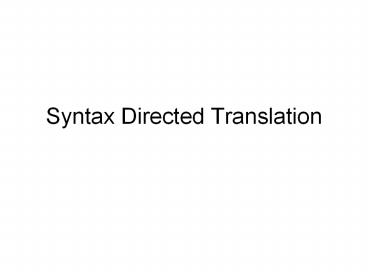Syntax Directed Translation - PowerPoint PPT Presentation
Title:
Syntax Directed Translation
Description:
We augment a context-free grammar by adding semantic rules or actions to each production. ... We call this augmented grammar an attribute grammar. Two types of ... – PowerPoint PPT presentation
Number of Views:129
Avg rating:3.0/5.0
Title: Syntax Directed Translation
1
Syntax Directed Translation
2
Why do we need Syntax-directed?
- To translate a programming language construct, a
compiler may need to keep track of many
quantities besides the code generated for the
construct. - Syntax-directed
- We augment a context-free grammar by adding
semantic rules or actions to each production. - These rules define the values of attributes and
how to compute them. - We call this augmented grammar an attribute
grammar. - Two types of attributes
- synthesized attribute which computes the value
based on the children - inherited attribute computed based on the parent
and the older siblings. - We can use two methods to translate the
programming language - a formalism, syntax- directed definition
- a more procedural notation called translation
scheme.
3
Syntax-directed definition(1/2)
- Syntax-directed definition
- A grammar -oriented compiling technique
- It is very helpful for organizing the compiler's
front end and it translates infix expression into
post form - Postfix notation
- 1) If E is a variable or constant, then the
postfix notation for E is E itself. - 2) If E is an expression of the form E1 op E2
where op is any binary operator, then the postfix
notation foe E is E1' E2' op. - 3) If E is an expression of the form (E1), then
the postfix notation for E1 is also the postfix
notation for E.
4
Syntax-directed definition(2/2)
- Essentially a formal treatment of two simple
concepts - Each node of a parse tree can have a set of
associated values (attributes). - The creation and traversal of parse trees can be
automated - Example
- if we have a production
- A --gt X1 X2 ... Xn
- we might have a rule
- A.a f(X1.a,X1.b,X2.a,X2.b,...,Xn.a,Xn.b)
- which describes how the attribute a of A is
defined in terms of attributes of the children of
A.
5
Translation scheme(1/2)
- A translation is an iuput-output mapping
- The output for each input x is specified in the
following way - construct a parse tree for x
- compute the value using semantic rule for
attribute associated with the X-production used
at node n - two types of attributes
- synthesized attribute which computes the value
based on the children - inherited attribute computed based on the parent
and the older siblings - A translation scheme gives a procedural
description of an action to be taken when a
production is applied
6
Translation scheme(2/2)
- The actions may be interspersed with the symbols
on the right-hand side of the production - thus indicating an evaluation order
- For example, in a translation scheme used to
generate assembly code - while-stmt --gt while generate label
L1,L2 emit("L1" )
expression emit("beqz L2")
statement
emit("b L1) emit("L2") - Attributes may be evaluated during parsing or in
a separate pass over the parse tree - Different strategies are used, depending whether
a top-down or bottom-up parser is used
7
How attributes are evaluated depends on whether
they are synthsized or inherited
- A synthesized attribute of a symbol is one which
depends only on the attributes of its children
(in the parse tree) - An inherited attribute is one which depends on
attributes of the parent or siblings (ex. the
data type of an identifier) - In general, inherited attributes are more
difficult to deal with, particularly for
bottom-up parsers
8
How attributes are evaluated depends on whether
they are synthesized or inherited.
- A synthesized attribute of a symbol is one which
depends only on the attributes of its children
(in the parse tree) - for example, the value of an expression.
- An inherited attribute is one which depends on
attributes of the parent or siblings - for example the data type of an identifier.
- In general, inherited attributes are more
difficult to deal with, particularly for
bottom-up parsers.
9
(No Transcript)
10
(No Transcript)
11
(No Transcript)
12
(No Transcript)
13
- When the syntax-directed definition has only
synthesized attribute, it is a S-attribute
definitions. It can be computed by using
bottom-up parser. While a syntax-directed
definition is L-attribute if each inherited
attribute of X_j, 1lt j lt n, on the right side
of A-gt X1X2Xn, depends only on - 1) the attribute of the symbols
X1,X2,,Xj-1 to the left of Xj in the production
and - 2) the inherited attributes of A.
14
- Every S-attributed definition is L-attributed,
because the restriction 1) and 2) apply only to
inherited attributes. It can be computed in
depth-first order. All syntax-directed
definition based on LL(1) grammars are
L-attributed. - Following are some examples of S-attributed and
L-attributed - 1) synthesized attribute on the parser
stack - 2) A non-L-attributed syntax-directed
definition
X X.x
Y Y.y
Z Z.z
Production Semantic rule
A -gt LM L.i l(A,I)
M.i m(L.s)
A.s f(M.s)
A -gt QR R.i r(A.i)
Q.i q(R.s)
A.s f(Q.s)































